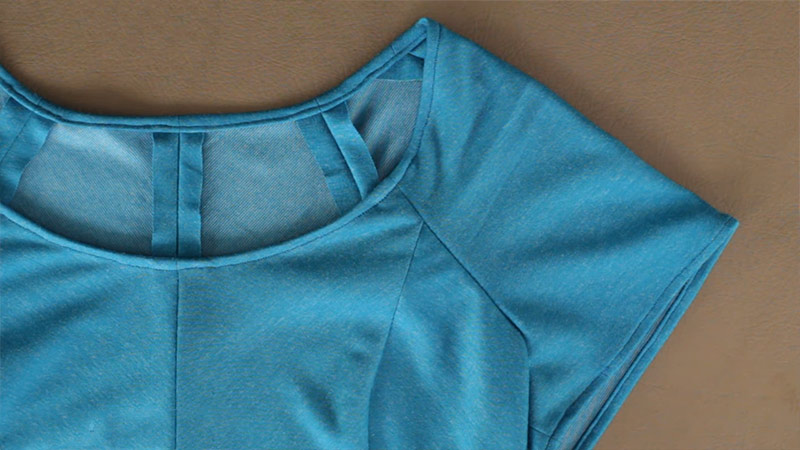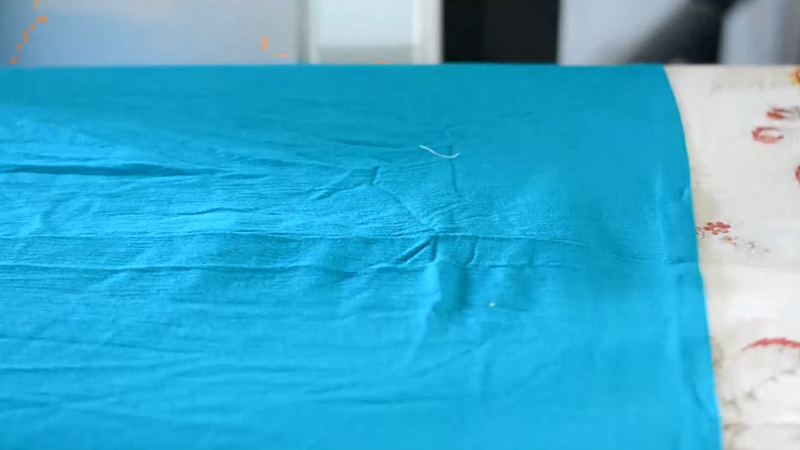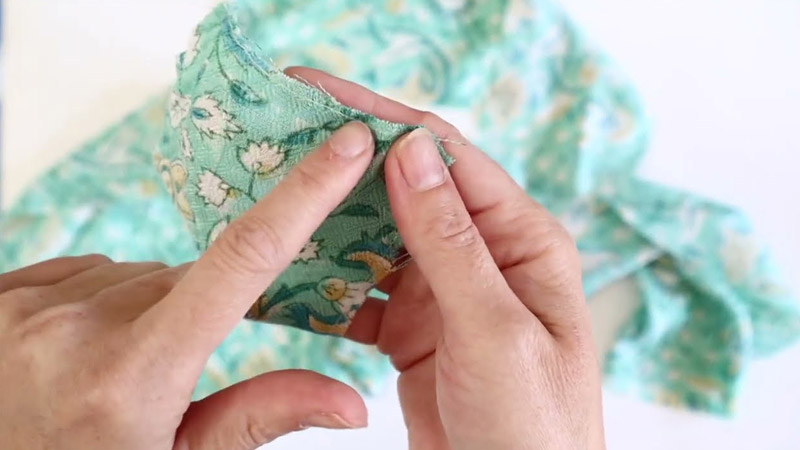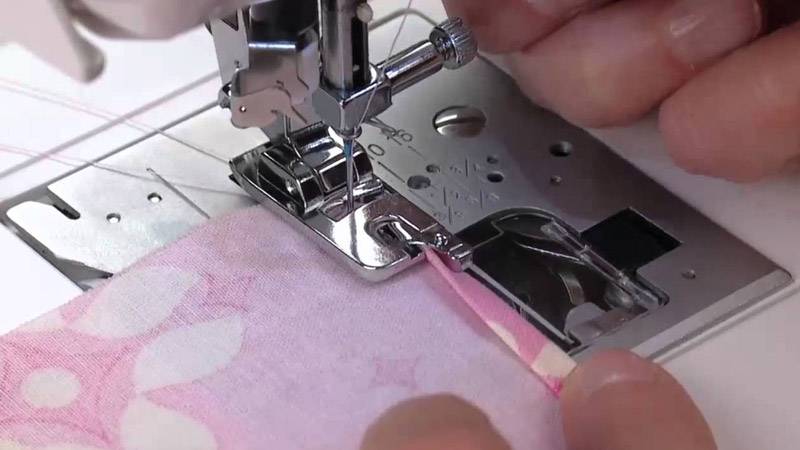Narrowing in sewing is a fundamental technique that empowers crafters and fashion enthusiasts to sculpt fabric, ensuring a precise fit and refined aesthetics in their creations.
This versatile method involves strategically reducing the width of specific sections of fabric, allowing for customized tailoring, improved comfort, and intricate design details.
Whether crafting a well-fitted bodice, tapering a pair of trousers, or adding decorative pintucks to a garment, narrowing is a key tool in a seamstress’s arsenal.
This introduction explores the art and science of narrowing in sewing, shedding light on its purpose, methods, and the creative possibilities it unlocks, providing a foundation for anyone eager to delve into the world of garment construction.

What Is Narrowing in Sewing?
Narrowing in sewing refers to the technique of making a fabric section or seam narrower than its original width. This technique is commonly used to create shape, fit, or design elements in clothing and other fabric-based projects.
Narrowing can be done in various ways, and it plays a crucial role in achieving a tailored and polished look in sewing.
Here are some key aspects of narrowing in sewing:
Purpose
Narrowing is often employed to enhance the fit and appearance of a garment. By reducing the width of a particular section, it can create a more flattering silhouette, eliminate excess fabric, or achieve specific design details.
For example, narrowing may be used to taper the waist of a dress, make sleeves slimmer, or create a fitted bodice.
Methods of Narrowing:
- Darts: Darts are folded and stitched seams that taper fabric in a specific area, usually to accommodate curves in the body, like the bust, waist, or hips. They are commonly used in bodices, skirts, and trousers to improve fit.
- Tucks: Tucks are narrow, folded fabric sections that are stitched down. They can be used decoratively or to reduce fabric width. Pin-tucks and pintucks are examples of decorative tucking techniques.
- Gathering: Gathering involves the use of stitches to gather fabric in a controlled manner, reducing its width while creating fullness in the process. It’s often used in sleeves, ruffles, and skirts.
- Seam Tapers: Seam tapers involve gradually narrowing the seam allowance as it progresses, allowing for a smooth transition from a wider section to a narrower one.
Tools and Notions
Depending on the method chosen, sewers may require tools such as sewing machines, needles, pins, fabric markers, and measuring tapes.
Pressing tools like irons and tailor’s hams are also crucial for achieving clean and professional-looking narrow seams.
Pattern Alterations
To achieve narrowing in sewing, pattern alterations may be necessary. This involves adjusting the pattern pieces before cutting the fabric to reflect the desired changes in width or shape. Pattern alterations require an understanding of garment construction and fitting.
Skill and Precision
Narrowing requires precision and attention to detail. The stitching must be accurate, and any changes in width should be consistent and even.
Beginners may find it challenging to achieve a neat and polished result, but with practice, they can improve their sewing skills.
Design Considerations
Narrowing can be a design element in itself. For example, a tapered leg on a pair of pants or narrowing towards the waist on a dress can add style and visual interest to a garment. Designers often use narrowing creatively to achieve specific looks.
What Is Narrowing in Sewing Clothes?

Narrowing in sewing clothes refers to the process of making a section of fabric or a seam narrower than its original width to achieve specific fit, design, or shaping goals in a garment.
This technique is commonly used in clothing construction to create a more tailored and polished look.
Here’s a closer look at narrowing in sewing clothes:
Fit and Shaping
Narrowing is often used to improve the fit of a garment. By reducing the width of certain sections, such as the waist, hips, or bust, the clothing can conform more closely to the wearer’s body shape, resulting in a more flattering and comfortable fit.
Design Details
Narrowing is also a design element that can be employed to create various effects. For example, tapered legs on trousers, fitted sleeves, or shaping darts in a dress bodice can be achieved through narrowing techniques, adding style and visual interest to the clothing.
Methods of Narrowing
Several techniques are used for narrowing in sewing clothes, including:
- Darts: Folded and stitched seams that taper fabric to accommodate curves or create shaping.
- Tucks: Folded fabric sections that are stitched down, often used decoratively or to narrow a garment.
- Gathering: Stitches are used to gather the fabric in a controlled manner, creating fullness while reducing width.
- Seam Tapers: Gradual reduction of seam allowance width, resulting in a tapered seam.
Pattern Alterations
In many cases, narrowing in sewing clothes involves modifying the pattern pieces before cutting the fabric. These alterations ensure that the narrowed sections align with the desired measurements and design intent.
Tools and Notions
Sewers typically use sewing machines, needles, pins, fabric markers, measuring tapes, and pressing tools like irons to execute narrowing techniques effectively.
Skill and Precision
Achieving successful narrowing in clothing construction requires precision and attention to detail. The stitching must be accurate, and any changes in width should be even and consistent for a professional finish.
What Is Narrowing in Sewing by Hand?

Narrowing in sewing by hand is a technique that involves manually reducing the width of a section of fabric or a seam in a sewing project.
It’s a fundamental skill in hand sewing, allowing crafters to achieve precise fit adjustments, create design elements, or add shaping to garments and other fabric-based items.
Here’s a more detailed explanation of narrowing in sewing by hand:
Fit and Shaping
Hand narrowing is often used to improve the fit of a garment or to add shaping. By skillfully stitching along specific areas, such as the waist, bust, or hips, sewers can customize the fit to better match the wearer’s body shape, resulting in a well-tailored and comfortable garment.
Design Details
Hand narrowing is also a versatile technique for incorporating design elements into sewing projects.
It allows for intricate control over fabric manipulation, making it possible to create decorative tucks, pleats, or gathers, enhancing the overall aesthetic of the item.
Methods of Hand Narrowing
Hand-sewing techniques for narrowing include:
- Basting Stitch: A temporary, long-running stitch used to gather fabric or reduce its width.
- Running Stitch: A basic straight stitch used to secure folded fabric or narrow a seam.
- Backstitch: A strong, secure stitch suitable for narrowing seams and adding strength to a seam.
- Slip Stitch: An almost invisible stitch used for closing seams or hems, often used in delicate or lined fabrics.
Pattern Alterations
Similar to machine sewing, hand narrowing may involve modifying pattern pieces before cutting the fabric. This ensures that the narrowed sections align correctly with the desired measurements and design intentions.
Tools and Notions
Hand narrowing requires basic sewing tools such as hand-sewing needles, pins, thread, fabric markers, and measuring tapes. Thimbles can also be helpful to protect your fingers from repeated needle pricks.
Skill and Precision
Hand sewing, including narrowing, demands precision and careful attention to detail. It requires steady hands and accurate stitching to achieve consistent and even results. Practice and experience are key to mastering this skill.
What Is Narrowing in Sewing Machine?

“Narrowing” in the context of sewing machines typically refers to a specialized technique or function that allows you to reduce the width of a seam or stitching line. This feature is particularly useful in garment construction, quilting, and other sewing projects.
Here’s a detailed explanation of narrowing in sewing machines:
Purpose
Narrowing on a sewing machine serves multiple purposes, primarily related to altering the width of seams or stitches. It allows you to customize your sewing projects by making adjustments to fit, style, or design elements.
Methods of Narrowing on a Sewing Machine:
- Adjustable Stitch Width: Many modern sewing machines come with adjustable stitch width settings. This feature allows you to increase or decrease the distance between the needle and the edge of the fabric, effectively narrowing or widening the seam or stitch.
- Overedge or Overlock Stitch: Overlock stitches are commonly used for finishing edges and creating narrow seams on knits and woven fabrics. Sewing machines equipped with overlock or serger functions can efficiently narrow the fabric edges while preventing fraying.
- Twin Needle Stitching: By using a twin needle, you can create parallel rows of stitching, effectively narrowing the fabric between the two rows of stitches. This technique is often used for decorative topstitching and hemming.
- Straight Stitch Plate: Some sewing machines have a straight stitch plate or throat plate that allows you to create narrower seams with precision. These plates have smaller needle openings, reducing the risk of fabric getting pulled into the machine.
Applications
- Tailoring and Alterations: Narrowing can be used to adjust the fit of garments by reducing the seam allowance in specific areas such as the waist or hips.
- Decorative Stitching: Narrowing enables you to create decorative elements like pintucks, pleats, and narrow topstitching for added style.
- Quilting: Quilters often use narrow seams for piecing together quilt blocks and achieving precise quilted designs.
- Edge Finishing: Overlock stitches are employed for neat and narrow edge finishing, especially on knit fabrics.
Tools and Notions
To utilize narrowing features on a sewing machine, you primarily need the machine itself, appropriate needles, and the right thread.
Some machines also come with specialized presser feet and stitch plates for specific narrowing techniques.
Skill and Precision
Using narrowing features on a sewing machine requires an understanding of your machine’s capabilities and settings.
Achieving precise results often depends on selecting the correct stitch width and adjusting tension as needed.
Mistakes to Avoid When Narrowing in Sewing
Narrowing in sewing can be a valuable technique when used correctly, but like any sewing skill, it comes with potential pitfalls.
Here are some common mistakes to avoid when narrowing in sewing:
Inaccurate Measurements
Accurate measurements are the foundation of successful narrowing in sewing. Rushing through this step or failing to measure carefully can lead to garments that don’t fit correctly.
Always use a reliable measuring tape or ruler, double-check your measurements, and ensure the fabric is flat and undistorted when measuring.
Ignoring Fabric Type
The choice of fabric greatly impacts how narrowing techniques should be applied. Lightweight and delicate fabrics, like silk, require special attention with finer needles and reduced tension.
Heavier fabrics, on the other hand, may necessitate stronger needles and thicker thread. Consider the fabric’s properties to achieve the desired results.
Skipping the Pressing Step
Pressing seams with an iron is crucial for achieving a polished look. It sets the stitches, removes wrinkles, and shapes the fabric.
Make sure to press both sides of the fabric for the best results. Neglecting this step can lead to a less professional appearance.
Not Securing the Beginning and End of Seams
Failing to secure the beginning and end of your seams can result in unraveling over time. Always backstitch or use another securing method to anchor your seams securely, ensuring they remain intact.
Uneven Stitching
Sewing with uneven or wobbly stitching lines can detract from the overall quality of your project.
To avoid this, guide the fabric evenly through the sewing machine by using guides, markings, or a presser foot with measurements.
Taking your time to maintain a consistent seam allowance will result in neater, more even stitching.
Over-trimming
While it may be tempting to trim excess fabric close to the seam, this can weaken the seam and make adjustments difficult. Instead, leave a small seam allowance, typically around 1/4 inch (6mm) or as specified in your pattern, to ensure the seam remains strong.
Neglecting the Seam Finish
It’s essential to finish the raw edges of your fabric to prevent fraying. Depending on the fabric type, this can be done using techniques like serging, pinking shears, or zigzag stitching. Neglecting this step can lead to frayed edges and a less durable final product.
Ignoring Pattern Alterations
If you’re working with a sewing pattern, accurately follow the instructions for pattern alterations.
Incorrect adjustments can result in a poorly fitting garment. Take the time to make precise modifications to ensure a proper fit.
Rushing the Process
Sewing requires patience and attention to detail. Rushing through the narrowing process can lead to errors and frustration.
Take breaks if needed and approach your sewing projects with a calm and methodical mindset.
Not Testing on Scrap Fabric
Before starting your main project, practice the narrowing technique on a scrap piece of the same fabric.
This allows you to familiarize yourself with the fabric’s behavior and troubleshoot any issues before working on your actual project.
Lack of Practice
Like any skill, narrowing in sewing improves with practice. Don’t be discouraged by initial mistakes; they’re part of the learning process.
Regular practice will help you refine your technique and become more confident in your sewing abilities.
FAQS
What is a narrow seam?
A narrow seam is a sewing seam with a minimal seam allowance, typically around 1/4 inch (6 mm) wide, used for fine or delicate fabrics or for creating a clean and understated finish in sewing projects.
Are there any common
Yes, some common mistakes include uneven stitching, failing to properly secure the beginning and end of a dart or seam, and neglecting to press the fabric to maintain a crisp finish.
Can narrowing be used for mending or altering existing garments?
Absolutely! Narrowing techniques can be invaluable for altering or repairing existing clothing items to achieve a better fit or fix damaged areas.
Is narrowing only used for clothing?
While narrowing is frequently applied in garment construction, it can also be used in various sewing projects beyond clothing.
Do I need advanced sewing skills to incorporate narrowing into my projects?
Not necessarily. While some narrowing techniques may require more expertise, many basic methods, such as sewing darts, are suitable for beginners.
To Recap
In Sewing, narrowing is a vital skill that elevates the craft of garment construction to new heights of precision and artistry. This technique allows sewers to transform flat fabric into tailored masterpieces, enhancing fit, comfort, and aesthetics.
Whether it’s the subtle shaping of darts, the decorative allure of pintucks, or the elegant tapering of seams, narrowing opens a realm of possibilities in the world of fashion and textiles.
Mastery of this art requires dedication, practice, and an understanding of both pattern alteration and design principles.
As aspiring sewers embark on their creative journeys, the knowledge and expertise gained in narrowing will undoubtedly be a key to achieving professional and personalized results in their sewing projects.
Leave a Reply